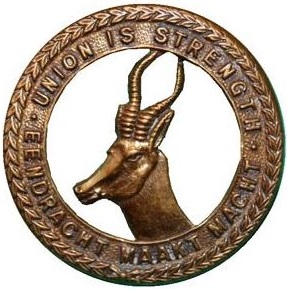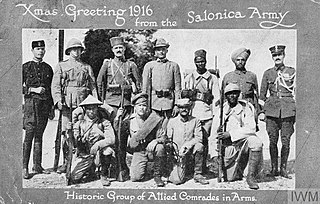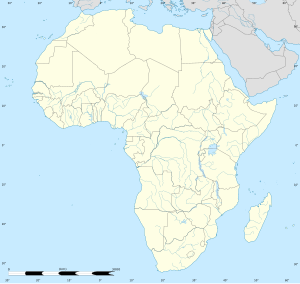
The Central Powers, also known as the Central Empires, were one of the two main coalitions that fought in World War I (1914–1918). It consisted of the German Empire, Austria-Hungary, the Ottoman Empire, and Bulgaria; this was also known as the Quadruple Alliance.

The Western Front was one of the main theatres of war during the First World War. Following the outbreak of war in August 1914, the Imperial German Army opened the Western Front by invading Luxembourg and Belgium, then gaining military control of important industrial regions in France. The German advance was halted with the Battle of the Marne. Following the Race to the Sea, both sides dug in along a meandering line of fortified trenches, stretching from the North Sea to the Swiss frontier with France, the position of which changed little except during early 1917 and again in 1918.

German East Africa was a German colony in the African Great Lakes region, which included present-day Burundi, Rwanda, the Tanzania mainland, and the Kionga Triangle, a small region later incorporated into Mozambique. GEA's area was 994,996 km2 (384,170 sq mi), which was nearly three times the area of present-day Germany and almost double the area of metropolitan Germany at the time.

The South West Africa campaign was the conquest and occupation of German South West Africa by forces from the Union of South Africa acting on behalf of the British imperial government at the beginning of the First World War. The South African Prime Minister Louis Botha took the unusual move of leading his troops into battle as commander-in-chief, to the frustration of his cabinet.

The Allies or the Entente was an international military coalition of countries led by France, the United Kingdom, Russia, the United States, Italy, and Japan against the Central Powers of Germany, Austria-Hungary, the Ottoman Empire, and Bulgaria in World War I (1914–1918).

The Balkans theatre or Balkan campaign was a theatre of World War I fought between the Central Powers and the Allies.

The African theatre of the First World War comprises campaigns in North Africa instigated by the German and Ottoman empires, local rebellions against European colonial rule and Allied campaigns against the German colonies of Kamerun, Togoland, German South West Africa, and German East Africa. The campaigns were fought by German Schutztruppe, local resistance movements and forces of the British Empire, France, Italy, Belgium, and Portugal.

The East African campaign in World War I was a series of battles and guerrilla actions, which started in German East Africa (GEA) and spread to portions of Mozambique, Rhodesia, British East Africa, the Uganda, and the Belgian Congo. The campaign all but ended in German East Africa in November 1917 when the Germans entered Mozambique and continued the campaign living off Portuguese supplies.

The South African Overseas Expeditionary Force (SAOEF) was a volunteer military organisation in World War I.

The Macedonian front, also known as the Salonica front, was a military theatre of World War I formed as a result of an attempt by the Allied Powers to aid Serbia, in the autumn of 1915, against the combined attack of Germany, Austria-Hungary and Bulgaria. The expedition came too late and with insufficient force to prevent the fall of Serbia and was complicated by the internal political crisis in Greece. Eventually, a stable front was established, running from the Albanian Adriatic coast to the Struma River, pitting a multinational Allied force against the Bulgarian army, which was at various times bolstered with smaller units from the other Central Powers. The Macedonian front remained stable, despite local actions, until the Allied offensive in September 1918 resulted in Bulgaria capitulating and the liberation of Serbia.

The Battle of Salaita Hill was the first large-scale engagement of the East African Campaign of the First World War to involve British, Indian, Rhodesian, and South African troops. The battle took place on February 12, 1916, as part of the three-pronged offensive into German East Africa launched by General Jan Smuts, who had been given overall command of the Allied forces in the region.
The Battle of Latema Nek took place during the East African Campaign in World War I.

The Battle of Kondoa Irangi took place during the East African Campaign of World War I.

The Battle of Ngomano or Negomano was fought between Germany and Portugal during the East African Campaign of World War I. A force of Germans and Askaris under Paul Emil von Lettow-Vorbeck had recently won a costly victory against the British at the Battle of Mahiwa, in present-day Tanzania and ran very short of food and other supplies. As a consequence, the Germans invaded Portuguese East Africa to the south, both to supply themselves with captured Portuguese materiel and escape superior British forces to the north.
The Battle of Mlali was fought during the East African Campaign of World War I. In mid-August 1916, the British General Jan Christiaan Smuts led three divisions from Kenya south into the Imperial German colony of Tanganyika to seize and disrupt their vital railway. The German commander Paul von Lettow-Vorbeck was informed by his scouts of the British movement and sent Captain Otto to investigate.
The Battle of Kibata was fought north-west from Kilwa during the East African Campaign of World War I. The British theatre commander, South African General Jan Smuts, planned to seize Kibata and prevent German forces from withdrawing southwards.
Gerald "Tommy" W. Thompson was a South African rugby union player who played for Somerset West Rugby Club. He was selected for the provincial team of Western Province in 1912. He was selected to participate in the 1912–13 South Africa rugby tour to the British Isles and France, and was capped in three tests, against Scotland, Ireland and Wales, all in 1912. He played in a further 12 matches against club sides. He was considered one of the two best of an outstanding pack of South African forwards.

The Monastir offensive was an Allied military operation against the forces of the Central Powers during World War I, intended to break the deadlock on the Macedonian front by forcing the capitulation of Bulgaria and relieving the pressure on Romania. The offensive took the shape of a large battle and lasted for three months and ended with the capture of the town of Monastir. On an average depth of 50km, the Bulgarian First Army gave battle on six occasions, being forced to retreat five times.

Karl Freiherr von Pflanzer-Baltin was an Austro-Hungarian general who was active in World War I.
Major Georg Kraut was born in Hildesheim by Georg and Auguste Kraut, née Hoppenstedt. Together with his four siblings Anne, Carl, Luise and Wilhelm Kraut, he grew up in a Lutheran family of lawyers. He was an officer of the Imperial German Army during the First World War, a veteran of the Schutztruppe, and the second-in-command of Paul von Lettow-Vorbeck. He was active in German East Africa. He participated in multiple battles, including the Battle of Tanga, the Battle of Salaita Hill, and the Battle of Iringa. Post-war, he joined the Freikorps with Lettow-Vorbeck and helped suppress the Spartacist Revolt.
















